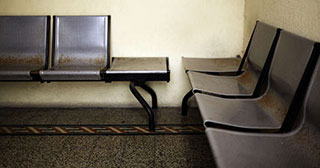Furniture FAQ
Office Chair FAQ
Where can I buy office chairs?
You have many options when it comes to where to buy office chairs—and, happily, it's something you can easily do from your office by shopping on Quill.com. You can also find desk chairs at many office supply and big box stores, too.
How do I fix an office chair?
When you find an office chair you love, it's like a dream come true—which makes for a nightmare when that chair has a problem. If you're trying to figure out how to fix an office chair, you're likely dealing with one of two issues: sinking or wobbling.
There are a few ways to fix a sinking office chair (which sinks, or stays at its lowest level, because the seal in the chair cylinder has worn out and the nitrogen gas that allows it to move is escaping). If you're amenable to a temporary fix that won't allow you to adjust your chair once you've set the height, you can get away with using an adjustable pipe clamp, a straight pipe fitting, and some pipe insulation for this hack. If you're looking for a permanent fix for your sinking desk chair, however, you need to completely replace the cylinder. Unless you're sure you have the right tools to remove the old cylinder, you may want to look for a complete cylinder replacement kit that provides you with everything you need.
To fix a wobbly office chair, the first step is to identify the root of the problem. Start by turning the chair upside down and inspecting each wheel. If any are bent or damaged, you need to replace them. Most can be removed with a screwdriver. If the wheels look fine, move on to the legs and search for missing screws. If you need to purchase a replacement, take one of the existing screws with you to the hardware store. The final potential cause for a wobbly office chair is the back plate on the bottom of the seat, where you can check for loose or missing screws or bolts as well as damage to the plate itself (which may require you to order a replacement using the make and model number of the office chair).
How do I adjust my office chair?
Every office chair make and model is a little different, so the exact steps to adjust your particular chair may differ from others. If you have trouble understanding the function of each knob and lever on your chair, or can't quite figure out how to adjust your office chair tilt or make it taller, your owner's manual is the best source of information.
However, many office chairs have a few key features in common, such as height adjustment (typically a lever or paddle beneath the seat cushion, sometimes to the right or left), and back height adjustment (which may either use a ratchet for adjustment, meaning you slowly lift it to the desired height, or a knob). The tilt of both the seat and the chair back is also a likely option, but manufacturers tend to put this lever in a variety of spots, so unless it's labeled, you may need to refer to your manual or contact the manufacturer for specific instructions.
The other important aspect of adjusting your office chair is to set it up ergonomically. To do this, begin with the seat height, adjusting the seat so it reaches just below your knee caps. Your feet should be flat on the floor with your knees at 90 degrees when you sit against the back of the chair.
Then, if your seat depth is adjustable, try moving the seat toward the chair back (or away from it), aiming to have a space roughly the size of a clenched fist between the back of your knee and the front of the seat when you sit down. Shorter people will need the seat closer to the chair back, and those with longer legs will move the seat farther from the back.
Adjust your lumbar support next, if your chair has this feature available. The idea is for the lumbar support to fit the natural curve of your spine at the small of the back. This might involve adjusting the height of the chair back.
All that's left to adjust are the arms and headrest, if your chair has one. Arm height should allow your arms to rest naturally at your side, elbows bent at 90 degrees, with no strain on your upper back and shoulders. You may find that your chair arms are depth adjustable, too, or that the arms can turn in and out to accommodate people with wider or thinner frames. Many arm rests are removable, and, if they keep your arms from resting naturally, you can remove them entirely. If you have a headrest, aim for support and comfort while keeping your head in a position that puts you at eye level with your monitor.
How do I disassemble an office chair?
If you move offices or if you need to ship your office furniture, you need to know how to disassemble an office chair. Luckily, many manufacturers use similar attachment points—and sometimes even the same hardware—so even though every chair is slightly different, the following steps should be a good start for taking your chair apart.
First, put the chair on its side and remove the wheels, either by pulling them, pressing a lever on each wheel, or twisting them free. If none of those options work, you may need to use a flathead screwdriver and pry bar. Then, detach the armrests using a screwdriver to unscrew them from the seat.
At this point, you're ready to pull your chair from the base. This involves removing any screws or bolts that attach the back to the base, unless your chair back and base are permanently attached. If they're permanently attached, see whether the hydraulics are also attached to the chair. If not, pull the chair away from the hydraulics. If they are attached, remove any screws, bolts, or hardware before lifting and pulling the seat and hydraulic assembly out from the base of the chair.
How do I make my office chair more comfortable?
Considering how much time many of us spend in our office chairs, it's crucial that they feel comfortable. But if you don't love the way your chair feels and aren't in the market to buy a new one, you're probably looking for a few ways to make your old office chair more comfortable.
Start by evaluating how you sit in your chair. When you sit up straight and have both feet on the floor, can you sit back against the backrest? Can your feet comfortably rest flat on the floor? If not, those are the first adjustments to make. Because, remember, no chair will be comfortable if your posture is out of whack.
To properly set up your chair to benefit good posture, push your hips all the way back in your chair and adjust the seat height so that your feet are flat on the floor with your knees at the same height as (or slightly lower than) your hips. The chair back should be at a 100- to 110-degree reclined angle, which may be achieved by moving your seat back or may require a small pillow or cushion. Make sure your arm rests allow your shoulders to relax, and if they're in the way you can remove them entirely. And, while your keyboard isn't technically part of your chair, make sure it's directly in front of your body and at a height that allows you to use it with relaxed shoulders, slightly open elbows, and neutral wrists.
If your chair alone doesn't seem to be cutting it in the comfort department, you might want to invest in a lumbar support back cushion, footrest, or adjustable standing desk converter so that you can alternate between sitting and standing throughout the day.
How to remove wheels from an office chair
Is your chair rolling unevenly? Before you start shopping for a whole new office chair, you might want to replace the wheels. Caster wheels wear down over time, and that can make rolling around your office less than pleasant. Thankfully, it's easy to remove wheels from an office chair and replace them with new ones, which you can find at Quill.com or your local hardware store.
If the wheels are attached without a fastener, you can just turn your chair over and pull them out with a forceful yank, or you might find a lever or tab to press that will release them. But, if that's not the case, grab a flathead screwdriver and a pry bar. Use your screwdriver to carefully pry the caster out from the leg before placing the nail-pulling end of your pry bar between the chair leg and caster. Push down on the pry bar handle and watch the caster wheel come loose.


